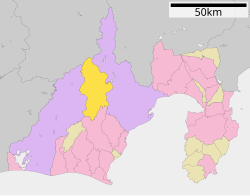Kawanehon, Shizuoka
|
Kawanehon 川根本町 |
|||
|---|---|---|---|
| Town | |||

Ōigawa Railway in Kawanehon Town
|
|||
|
|||
 Location of Kawanehon in Shizuoka Prefecture |
|||
| Coordinates: 35°2′49″N 138°4′53.9″E / 35.04694°N 138.081639°ECoordinates: 35°2′49″N 138°4′53.9″E / 35.04694°N 138.081639°E | |||
| Country | Japan | ||
| Region |
Chūbu Tōkai |
||
| Prefecture | Shizuoka Prefecture | ||
| District | Haibara | ||
| Area | |||
| • Total | 496.88 km2 (191.85 sq mi) | ||
| Population (September 2015) | |||
| • Total | 7,114 | ||
| • Density | 14.3/km2 (37/sq mi) | ||
| Time zone | Japan Standard Time (UTC+9) | ||
| - Tree | Japanese beech | ||
| - Flower | Rhododendron quinquefolium | ||
| Phone number | 547-56-1117 | ||
| Address | 627 Kaminagao, Kawanehon-chō, Haibara-gun, Shizuoka-ken 428-0313 | ||
| Website | Official website | ||
Kawanehon (川根本町 Kawanehon-chō?) is a town located in Haibara District, Shizuoka Prefecture, Japan. As of September 2015, the town had an estimated population of 7,114 and a population density of 14.3 persons per km². The total area was 496.88 square kilometres (191.85 sq mi).
Kawanehon is located in north-central Shizuoka, along the upper reaches of the Ōi River, with approximately 90% of the town area covered in forest and mountains. It is bordered to the north by the Japanese Alps, with peaks ranging to 2400 meters. Forests range from Siebold's Beech at lower elevations to Siberian Dwarf Pine at higher altitudes, and wildlife include wild boar and kamoshika. The area enjoys a temperate maritime climate with hot, humid summers and mild, cool winters.
Shizuoka Prefecture
Nagano Prefecture
The area of the present town Kawanehon is on the border between the former provinces of Suruga and Tōtōmi, and was mostly tenryō territory under direct control of the Tokugawa shogunate in the Edo period. During the cadastral reform of the early Meiji period in 1889, the area was reorganized into numerous villages within both Haibara and Shida Districts within Shizuoka Prefecture. Kawanehon was formed on September 20, 2005 by the merger of the former towns of Nakakawane and Honkawane, both from Haibara District.
...
Wikipedia



